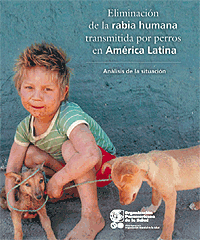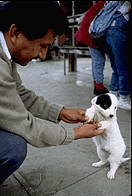Elimination of Dog-Transmitted Human Rabies in Latin America: Situation Analysis

Full Text (in Spanish, PDF, 73 pp, 2278 Kb; chapter headings translated for user orientation)
Divided into individual chapters and 21 country profiles
- Cover and Contents
- Preface by the PAHO Director
- Acknowledgements
- Introduction (text to right)
|
1. Latin America: Epidemiological Situation and Control Measures (this structure is repeated throughout the country profiles, each 2pp with graphics) | |
2. Argentina |
13. Haiti |
23. Final Considerations | |
- References
- Annex (data tables)

Evaluation Methodology: Elimination of Human and Dog Rabies in Latin America
Country Data: ![]() Consult the Epidemiological Surveillance System for Rabies, SIRVERA
Consult the Epidemiological Surveillance System for Rabies, SIRVERA
Action Plan for the Prevention and Control of Rabies in the Americas, 2005–2009 (in Spanish)

Epidemiological Situation of Rabies in Latin America in 2004, PAHO Epidemiological Bulletin, Vol 26, No. 1, March 2005)

PAHO Links
- Rabies
- Zoonoses / Animal Health
- Pan American Foot-and-Mouth Disease Center (PANAFTOSA)
 | |
Epidemiological Surveillance System on Rabies (Sistema de Vigilancia Epidemiológica en Rabia / SIRVERA) |
Virtual Library in Veterinary Public Health (VHL) |

Introduction | Final Considerations
In 1983, the countries of the Americas, with support from PAHO, made a commitment to eliminating dog-transmitted human rabies. Over the past 20 years, cases of human and canine rabies in Latin America have been reduced by 91% and 93%, respectively. |

Since 1983, the countries of the Americas have made major efforts to reach their goal of rabies elimination, within the framework of the Evaluation methodology to eliminate human and dog rabies in Latin America. The average number of cases of human and dog rabies in the Region has undergone a reduction of over 90%. During the last decade years, dogs have been the source of infection for 65% of all reported human cases.
For PAHO, the elimination of human and dog rabies in its Member States is both a priority for its technical cooperation and one of its mandates. With the aim of contributing to analyzing how to achieve this goal, PAHO—through its Veterinary Public Health Unit (HDM/VP)—proposed carrying out a study to evaluate the 2005 goal of Elimination of Human Rabies Transmitted by Dogs in Latin America, which generated this publication. The study was carried out in 21 countries with the common objective of analyzing the epidemiological situation of rabies in the Americas and the control measures taken to fight the disease. This analysis was used in 2005 as the technical basis for drafting a new Regional Plan for the Elimination of Human Rabies in Latin America and the Spanish-speaking Caribbean. In this joint Plan to which all countries contributed, the strategies for the final stage of the elimination of dog-transmitted human rabies was included, as well as other measures for the control of human rabies transmitted by wildlife.

The above study involved the participation of the following PAHO Member States: Argentina, Belize, Bolivia, Brazil, Chile, Colombia, Costa Rica, Cuba, the Dominican Republic, Ecuador, El Salvador, Guatemala, Haiti, Honduras, Mexico, Nicaragua, Panama, Paraguay, Peru, Uruguay, and Venezuela. The report on the study was prepared by the PAHO Veterinary Public Health Unit (VP), part of the Area of Health Surveillance and Disease Management (HDM) located at PAHO Headquarters in Washington, DC, with support from the Pan American Foot-and-Mouth Disease Center (PANAFTOSA) in Rio de Janeiro, Brazil. (PAHO, 2004)
The preliminary version of the report was presented to all HDM/VP advisors in the countries and was submitted for discussion at a meeting held in Buenos Aires in January 2004. In addition, two agencies from the Ministry of Health of Brazil (MS) participated in the discussions: the National School of Public Health (ENSP) of the Oswaldo Cruz Foundation (FIOCRUZ) in Rio de Janeiro and the Secretariat of Health Surveillance (SVS) in Brasilia. In addition, the Health Analysis and Statistics Unit (HDM/HA) at PAHO headquarters in Washington collaborated in the study.
To facilitate the analysis process, an interactive CD-ROM with the methodology for the study and other information was sent to each participating country, as well as a diskette with Excel forms for calculations and rabies data on rabies from each country. These data were obtained from the Epidemiological Surveillance System for Rabies (Sistema de Vigilancia Epidemiológica en Rabia / SIRVERA) coordinated by PANAFTOSA, which as part of the PAHO Veterinary Public Health Unit has maintained the system since the 1970s. The SIRVERA data used in the study, on rabies cases from 1990 to 2000, were vital for analyzing the epidemiological situation of rabies in the Americas and for devising control strategies.
Subsequent annual data from 2001 to 2003 were sent by the Member States. The calculation form contained a request for each country to disaggregate the data by first-level units, i.e. by state, department, or province. Upon inserting the data, calculations for rate and percentages were generated automatically, along with a series of figures.
The countries were also asked to report human and canine cases by second (municipal) level. The analyses prepared by each Member State were sent in on the calculation forms with text interpretations generated by the text processor. For trend analyses, the time series encompassed the period from 1990 to 2003. Other analyses were done on the last three years, i.e. 2001 to 2003. The analyses received from the countries were then summarized and published by an editorial committee supported by HDM/VP, which wrote the chapter on the regional situation and the final considerations and provided maps for geographical reference. All the material produced was reviewed by the countries following the editorial process.
The target groups for this publication are public health authorities and decision-makers from different levels and agencies in the Americas, as well as health professionals, researchers, academics, and students. Providing access to the information guided the publication process. The study is expected to promote review processes and new proposals from the participating countries in the application of study results by transforming them into a concrete, effective plan to comply with the PAHO mandate to eliminate dog-transmitted human rabies in its Member States.
The Region is very close to reaching its goal of eliminating dog-transmitted human rabies, utilizing the control measures currently available. |
The aforementioned experience of the Latin American countries over the past 20 years has led to a reduction of over 90% of human and canine cases, which proves that that disease can be controlled by taking effective action.
The governments also made political decisions to eliminate dog-transmitted rabies by allocating annual budgets of nearly US$ 40 million to reach this goal, as well as for training more personnel and by including rabies in their public policy agenda.

In Latin America, some 44 million dogs are vaccinated every year and steps have been taken to protect the approximately 1 million persons at risk of contracting the disease. Of these, 25% have received post-exposure treatment. More than 100 national and regional laboratories have integrated rabies diagnoses into their network and have processed nearly 74,000 samples per year. These figures show that the countries of the Americas are in a position to eliminate human rabies transmitted by dogs in the near future and also to reduce the number of human cases transmitted by wildlife.
When analyzing rabies in Latin America utilizing the current approach defined by PAHO to guide its technical cooperation, it can be said that different situations are applicable to the context of this disease. Among them are concepts to deal with the unfinished agenda, to maintain achievements made thus far, and to face new challenges.
In the six countries where cases of dog-transmitted human rabies still occur, a proposal has been presented to meet the objectives in the unfinished agenda: to work strategically and more intensely and to target special groups. People in Latin America people cannot continue to die from dog-transmitted rabies. As indicated in the study, the 27 cases of human rabies transmitted by dogs recorded in Latin America in 2003 occurred in only 0.2% of all second-level units (i.e. municipalities). This profile demonstrates that the disease occurs in specific areas that can be targeted. Similarly, cases of canine rabies in these municipalities are located in specific foci, although in some of them the number of cases is high. This indicates that if countries can determine their priority areas and intensify and diversify their control measures, it is highly probable that they will obtain excellent results.
It is important to point out that part of Latin America has already managed to eliminate the spread of the rabies virus in the canine population. A large part of the Southern Cone—i.e. Chile and Uruguay, vast areas of Argentina, and all of Southern Brazil, including São Paulo and Rio de Janeiro—is already free of dog rabies. Panama and Costa Rica are in a similar situation, as are some departments of Peru. In these areas, the recommended strategy for technical cooperation is to protect these achievements. The implementation of the surveillance and control measures necessary for eliminating rabies presupposes the continuity of political, technical, and budgetary support.
Recently, human rabies transmitted by bats has increased in epidemiological importance and can be seen as a new challenge. This mode of transmission is not new, but in 2004 the number of cases underwent an increase stemming from two major outbreaks reported in Brazil (affecting 14 people) and Colombia (affecting another 14 people), respectively. This is the first time the number of dog-transmitted human cases has been exceeded in the history of the Regional Program, i.e. since 1983.
Bat-transmitted human rabies requires more complex control strategies than does dog-transmitted cases. In general, bat-transmitted cases occur in remote areas, often in the jungle where access to health services still faces obstacles. In order to prevent outbreaks from bats, there is a need for joint strategies with other sectors, such as agriculture and the environment, as well as for defining the risk situation in order to act preventively. It is also necessary to care for people already attacked by bats.
PAHO has placed priority of some of the countries, e.g. Haiti and Bolivia, which currently have the highest numbers of cases for human and canine rabies and are thus key to the elimination process. Most of the human cases caused by dogs in the last three years have occurred in the peripheral areas of large cities among low-income populations. Examples of this are Port-au-prince in Haiti, San Salvador in El Salvador, and Fortaleza in Brazil. This suggests that dog-transmitted human rabies can be associated with poverty and uncontrolled urban growth.
The situation analysis for areas recording the greatest numbers of human rabies cases indicates that, in all probability, control measures are not being carried out in the recommended way. Low vaccination coverage in the dog population—for example, in Zulia State, Venezuela, and on the outskirts of San Salvador, El Salvador—can also be mentioned, as well as the lack of periodic vaccination in Haiti. Vaccinating dogs is the most important action a country can take to interrupt the spread of the virus in the dog population and an essential measure for areas where cases occur.
It should be pointed out that achievements have been made by some countries. Most notable are Mexico and Peru: whereas before they had a sizable number of cases, they registered no dog-transmitted human cases in 2002 and for the last three years of the study. Brazil has had a major reduction of the human dog-transmitted cases but still records a few, although the results of the control measures being carried out in the country are on average quite good. In these countries—due to their heterogeneity, complexity, and size—the study indicated a need to carry out more detailed analyses of internal control measures of each state, i.e. at the first-level geopolitical unit, since there are extensive geographical areas with hundreds of municipalities.
Preventive and post-exposure human treatment against rabies in the Americas has been decentralized to the state, province, or department level. The availability of free treatment in the health services of the Latin American countries has probably been an important factor in the reduction of the number of human cases. As a result, free preventive anti-rabies treatment for people is an achievement that should be maintained for the benefit of the population. In high-risk areas where canine cases still occur, human cases could be avoided if the population were well informed and knowledgeable of prophylactic measures and if treatment were available. To this end, education and communication activities in the national programs should be intensified. The proportion of people treated varies greatly when comparing the different countries and areas within them.
In this regard, it is recommended that each country analyze its geopolitical units to determine where too many or too few people are being treated, particularly in areas at risk of rabies. This measure can avoid unnecessary treatment and increase the availability of immunobiologicals in areas at greater risk, so that treatment can be rationally and adequately provided. Currently, epidemiological surveillance is fundamental for rabies control in the Region.
There are several extensive areas where there are no longer any canine cases, but these continue to exist in neighboring territories. Such is the case in the Department of Jujuy, Argentina, on the border with Bolivia, where rabies was reintroduced following several years without cases. Thus, intensification of epidemiological surveillance in border areas is one of the subjects that should be on countries' political agendas, as well as internal risk within the countries arising from inequalities and regional specificities.
The study suggests that an important percentage of first-level units in the countries of the Americas have been carrying out excellent epidemiological surveillance, as has been observed with regard to Mexico, Peru, and Brazil. This makes it possible to rely on data indicating that there have been no canine cases for several years, which means that these areas can be considered free of canine rabies. By contrast, there still are countries and areas within countries where surveillance is minimal, as is the case in Haiti, Ecuador, and Colombia. This situation forces us to rethink the needs of the countries with regard to rabies. Since 1983, the year in which the countries of the Region made their commitment to eliminating dog-transmitted human rabies, there have been not only significant changes regarding the epidemiological situation as presented in this study, but scientific advances as well. Tests for viral type and monoclonals are already being used routinely in various institutions and make it possible to know the species of transmitting animal. Furthermore, most of the countries have been using cell culture vaccines for rabies prevention and control, which has reduced the risks related to the use of other vaccines, such as those made from the brain of lactating mice.
The availability of rabies control strategies have been verified over decades, with the majority of the countries having successful experiences—not to mention the historical ties of solidarity between countries and support from the scientific community. All this leads us to believe that the goal of eliminating rabies can be reached very soon. The final effort made to deal with the obstacles previously identified and to maintain the results achieved to date is key for the elimination of dog-transmitted human rabies in Latin America. A new emerging challenge is human rabies transmitted by wildlife.